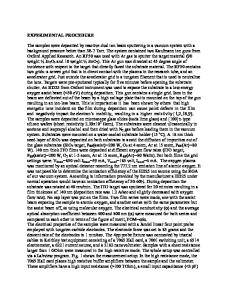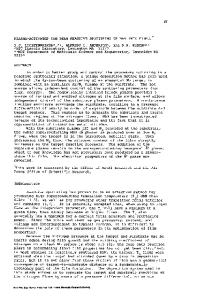Preparation of molybdenum-doped indium oxide thin films using reactive direct-current magnetron sputtering
- PDF / 130,530 Bytes
- 5 Pages / 612 x 792 pts (letter) Page_size
- 48 Downloads / 436 Views
High-mobility molybdenum-doped In2O3 films (IMO) were prepared on the normal glass substrate by reactive direct current magnetron sputtering from the molybdenum-embedded indium metal target. The effects of oxygen partial pressure, substrate temperature, and sputtering current on the optoelectrical properties of IMO films were investigated. The films with the highest carrier mobility of 50 cm2 V−1 s−1, as well as the average visible transmission greater than 80% including the 1.2-mm-thick glass substrate, were obtained. The minimum resistivity of the films is 3.7 × 10−4 ohm cm. The properties of the IMO films are sensitive to the oxygen partial pressure in the sputtering environment. X-ray diffraction measurements indicate that the films show In2O3 crystal structure.
I. INTRODUCTION
Transparent conductive oxide (TCO) films with high electrical conductivity and high optical transparency have been widely used for many applications.1,2 Of these films, In2O3:Sn (ITO), SnO2:F, and ZnO:Al are the most commonly used materials because of their good optoelectrical properties and their industrial applicability at relatively low processing temperature. Generally, there are two ways to improve the electrical conductivity of the TCO thin films; one is by increasing the free-carrier concentration, and the other is by enhancing the carrier mobility. Until now, the electrical conductivity of the TCO thin films has been mainly improved by increasing the free-carrier concentration. However, the increase of the carrier concentration may lead to the degradation of the optical properties due to free carrier absorption,3,4 whereas improving the electrical conductivity by increasing the carrier mobility can avoid sacrificing the optical properties. Consequently, carrier mobility enhancement is the more favorable alternative for high-quality TCO films.5 Zhang’s team first reported high-mobility molybdenum-doped In2O3 (IMO) films prepared by reactive evaporation6−9 and thereby attracted much more attention,10−15 not only because they represent a new way to explore the novel TCO materials, but also because TCO thin films with high mobility are of great significance in the development of transparent electronics due to high carrier mobility, which results in the high operation
a)
Address all correspondence to this author. e-mail: [email protected] DOI: 10.1557/JMR.2005.0184 1404
http://journals.cambridge.org
J. Mater. Res., Vol. 20, No. 6, Jun 2005 Downloaded: 27 Mar 2015
speeds in the transparent electronic devices.16,17 A high valence difference of 3 between the dopant Mo ions and substituted In ions in IMO films with high carrier mobility and high visible transmission may be ascribed to the low dopant Mo concentrations and need to be further studied. Furthermore, the fabrication of high-quality IMO films by reactive direct current (dc) magnetron sputtering could be more cost effective than the other reported techniques. In this study, reactive dc magnetron sputtering was used to deposit high-mobility IMO thin films with good crysta
Data Loading...










